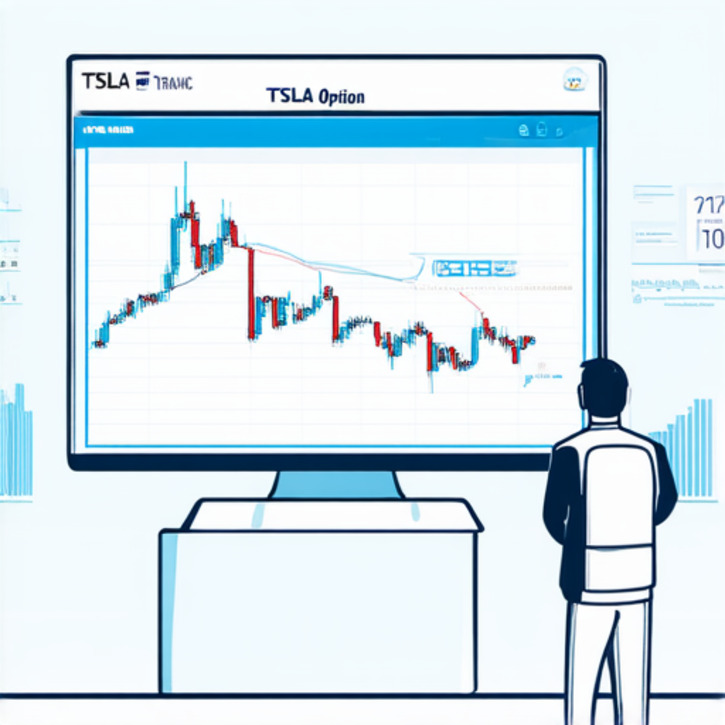TSLA Option Market Sentiment: What’s Driving the Price?

TSLA Option Market Sentiment: An Introduction
Nowadays, with the financial world evolving at breakneck speed, the TSLA option market is quickly grabbing the attention of savvy investors and traders alike. Whether you’re an old hand at this or just dipping your toe in the water, getting a feel for the mood behind TSLA option strategies can really give you a leg up. In the past, options mainly served as a way to hedge bets or take a gamble on future price moves, but as trading techniques have become more refined, these instruments have grown in appeal. With wild stocks like TSLA often leading the charge, understanding how market sentiment influences option pricing is more important than ever.
At its essence, a TSLA option is a contract that gives you the right—but never the obligation—to buy or sell Tesla shares at a set price before a specified deadline. This feature has evolved dramatically over the years and now plays a crucial role in both speculation and hedging strategies. Its rising popularity is a direct result of major shifts in market dynamics and tech advances that enable rapid-fire trading. As a result, TSLA option trading now wields notable influence over overall market sentiment, offering investors a solid tool to gauge trends and predict company performance.
What Is a TSLA Option and Why It Matters
In a nutshell, a TSLA option lets traders bet on future price swings of Tesla’s stock. It’s not just about buying or selling a share; it’s more about having a strategic view that factors in market volatility, the company’s performance, and broader economic signals. Many investors appreciate this tool for its flexibility and control—you can use a relatively small amount of capital to manage a much larger stake. With that leverage and the ability to guard against market downturns, it’s no wonder TSLA options are such a hot commodity.
The Evolution of TSLA Option Strategies
Over time, the strategies employed in the TSLA option market have seen a dramatic transformation. Back in the day, only the well-funded and highly experienced traders were dabbling in options, but now even more retail investors are trying their hand at complex strategies like spreads, straddles, and strangles. These approaches let you make nuanced plays based on how volatility and company performance might affect Tesla’s stock. Fueling this evolution are both technological breakthroughs in trading platforms and a wealth of educational resources, which have collectively leveled the playing field for everyday traders.
The Impact of Speculative Trading on TSLA Options
Speculative trading really shakes up the TSLA option market. When traders take speculative positions, they can cause immediate swings in option prices, affecting both premiums and overall demand. This type of trading often amplifies the market’s reaction to anything from company-specific headlines to broader economic events, leading to rapid pricing changes. For many, watching this speculative element is key to foreseeing market turnarounds and managing risks effectively. In the end, as speculative forces drive prices in unpredictable ways, both short-term traders and long-term investors need to keep their eyes peeled.
Key Drivers Behind TSLA Option Pricing
TSLA option pricing is shaped by a whole host of factors that go beyond simple supply and demand. The mix of market volatility, the performance of the underlying stock, and overall investor sentiment creates a unique trading environment. Breaking down these elements offers insights not just into the value of a TSLA option but also into wider market trends. Whether it’s a sudden spike in volatility or a shift in how investors view Tesla’s future, grasping these drivers is critical for anyone looking to thrive in this competitive space.
Think of market volatility as a major player in dictating TSLA option prices. Volatility measures just how wild the price swings can be over a short period, and when things get rough, option premiums usually shoot up to reflect the extra risk. With Tesla’s history of dramatic performance shifts—thanks to everything from earnings reports and innovative breakthroughs to leadership moves—any piece of news is bound to stir the pot. While this volatility can be challenging to manage, it also opens up plenty of opportunities for traders who know how to ride the wave.
Market Volatility and Its Effect on TSLA Option Values
When the market gets choppy, TSLA option values can change in the blink of an eye as investors tweak their risk models on the fly. Volatility acts like a double-edged sword: on one hand, it ups the chances for big gains, and on the other, it ramps up potential losses. Many traders design their strategies specifically to capture these wild swings, knowing that a turbulent market might just hand them profitable opportunities. This balancing act between risk and reward is at the very heart of TSLA option trading. In uncertain times, options become indispensable, giving traders a structured way to capitalize on erratic price swings while keeping downside risks in check.
The Influence of Company Performance on TSLA Option Pricing
Tesla’s own performance has a huge impact on the value of TSLA options. When Tesla posts strong earnings, unveils groundbreaking innovations, or even gets caught up in a controversy, the options market reacts quickly. Traders see these events as signals of what might lie ahead, causing option prices to jump or drop accordingly. It’s not just a snapshot of the current state but rather a forecast of future potential. By keeping an eye on company fundamentals and market mood, investors can better assess the opportunities in TSLA option trades.
Technical Analysis: Decoding TSLA Option Trends
Technical analysis is an essential tool in today’s trading toolkit, and TSLA options are no exception. Traders pore over charts, patterns, and various indicators to try and spot trends that hint at where prices might be headed. Many seasoned traders swear by these methods, appreciating how technical analysis helps untangle the complexities of the TSLA option market. Not only does this approach support strategic decision-making, it also helps in cutting down risk through timely actions. Plus, using technical analysis often reveals those subtle market signals that might easily be missed if you’d only looked at the numbers.
The real magic of technical indicators is that they can turn raw market data into actionable insights. For example, tracking metrics like volume and open interest gives a sense of the market’s energy and may even hint at reversals. When these signals are combined with historical chart patterns, investors can start to see a clearer picture of the trend’s direction and strength. This methodology is particularly powerful for TSLA option traders, arming them with the analytical instruments needed to navigate the choppy waters of Tesla’s frequently shifting market conditions.
Chart Patterns in TSLA Option Trading
Many traders treat chart patterns as their roadmap through the TSLA option market. Familiar patterns like heads and shoulders, double tops, and the classic support/resistance levels tend to pop up and offer valuable clues about where prices might head next. If these patterns are interpreted correctly, they can pinpoint ideal moments to jump in or bow out. For instance, a breakout pattern might suggest a coming price surge, nudging investors to act quickly. It’s a delicate blend of art and science—where numbers meet gut instinct—that keeps evolving with changing market trends.
Volume and Open Interest Dynamics in TSLA Option Markets
Volume and open interest are two key numbers that reveal a lot about how traders are feeling and how actively they’re participating in the market. A sudden spike in trading volume might indicate that a particular strike price or expiration date is catching eyes, perhaps because the big players are maneuvering for an upcoming move. On the flip side, rising open interest typically signals that investors are building long-term positions. Both of these metrics offer a rare glimpse into the collective mindset of market participants and are indispensable for anyone trying to make smart moves in the TSLA option space.
Utilizing Technical Indicators for TSLA Option Evaluations
There’s a whole arsenal of technical indicators that traders rely on to evaluate TSLA option trades. Tools like the Relative Strength Index (RSI), moving averages, and Bollinger Bands help paint a picture of whether the market is feeling overbought or oversold. These indicators add context to raw market movements and can signal the right moments to buy or sell. The trick is to combine these technical insights with a good grasp of overall market conditions, which leads to decisions that are both data-driven and contextually smart. This blend of technical know-how and market understanding is what can fine-tune strategies and potentially lead to more profitable trades.
Risk Management Techniques for TSLA Option Traders
Let’s face it—risk management is absolutely critical in the world of TSLA option trading, given how quickly prices can swing. Seasoned traders often use a cocktail of strategies, from stop-loss orders and careful position sizing to diversification tactics, to help cushion against those volatile moves. These risk management practices aren’t just about dodging losses; they’re a fundamental part of any solid trading game plan. By setting clear exit points and staying vigilant about market trends, traders can protect their portfolios from steep downturns, all while still seizing opportunities when they arise. Developing and sticking to these safety nets is key to long-term success in a market as unpredictable as TSLA options.
Fundamental Factors Affecting TSLA Option Value
While technical analysis definitely helps illuminate price trends and market mood, you can’t overlook the fundamental factors that shape the TSLA option landscape. Elements like macroeconomic events, company earnings, and overall industry trends play a pivotal role in setting TSLA option values. Many investors now realize that while charts might tell part of the story, the deeper economic and financial realities provide a critical backdrop. When you mix technical insights with an understanding of these underlying factors, you’re better positioned to handle the intricacies of the TSLA option market.
Macro indicators like inflation rates or shifts in the global economy often nudge the market’s risk appetite. For instance, changes in interest rates or unexpected geopolitical events might not directly impact Tesla’s performance, but they can stir up market volatility that eventually influences option pricing. This tight interlink between the wider economy and individual stock performance really underlines the importance of keeping an eye on the broader picture. For anyone focusing on TSLA option strategies, being mindful of these influences is a must for a balanced and informed trading approach.
Macro-Economic Events and TSLA Option Shifts
Big-picture macro events tend to ripple through all corners of the financial markets, including the TSLA option arena. When central banks adjust interest rates or trade policies get reshuffled due to international tensions, you can expect investor confidence—and option premiums—to take a hit. Such events often lead to increased market turbulence, making options a go-to hedging tool for many. By keeping tabs on macroeconomic trends and understanding their potential to shift risk perceptions, traders can strategically position themselves to benefit from subtle movements in TSLA option prices, even when these events don’t directly touch Tesla’s bottom line.
Earnings and Company Fundamentals Influencing TSLA Options
Earnings reports and the nitty-gritty of a company’s financials are the bedrock of many trading decisions. For TSLA option investors, understanding these fundamentals is crucial. A better-than-expected quarterly report, a successful product launch, or upbeat future guidance can set the stage for a favorable option trade. Conversely, falling short of expectations or a downward revision often triggers swift price corrections in the options market. Investors who skillfully integrate fundamental analysis into their strategies often enjoy better risk-adjusted returns, as they’re less prone to getting swept up in short-term market mood swings.
Industry Trends Driving TSLA Option Activities
Don’t forget that broader industry trends can also significantly impact TSLA option activities. Consider the ongoing push towards sustainable energy and rapid advancements in autonomous driving technology—both of which have fueled a buzz of optimism for Tesla. These trends open the door to fresh trading strategies as market participants align their portfolios with a forward-looking vision. Additionally, keeping an eye on how other players in the automotive and tech spaces are performing can provide a handy benchmark for assessing TSLA option opportunities. Staying updated on these industry shifts can help traders make smarter, well-informed decisions.
Sentiment Indicators: Gauging TSLA Option Buyer Perspectives
One crucial aspect of trading TSLA option strategies is grasping investor sentiment. Essentially, it’s all about tuning into the collective outlook and understanding buyer perspectives, often gauged through sentiment indicators and market surveys. These tools capture the full spectrum of market mood—whether it’s leaning bullish or bearish—and can occasionally serve as early warning signals of an impending shift. In a market as lively and unpredictable as TSLA options, sentiment metrics work hand in glove with technical and fundamental analysis, offering traders that extra bit of insight needed to time their moves just right.
Nowadays, real-time data from social media, news platforms, and specialized sentiment tools provides a constant stream of information about how investors feel. When these insights are overlaid with technical analysis, they can really sharpen a trader’s decision-making process. Keeping track of how narratives evolve online can alert you to emerging trends long before they hit the option prices. Often, a sudden spike or dip in sentiment can trigger a domino effect, aligning with broader trading movements and making it a must-watch metric for traders trying to refine their strategies.
Investor Sentiment Metrics for TSLA Options
There are several sentiment metrics that shine a light on how participants are feeling about TSLA options. Whether it’s the put-call ratio or volatility indexes derived from trading activities, these indicators help quantify the often elusive investor mood. For instance, a high put-call ratio might point to a bearish outlook, whereas a surge in volume accompanied by bullish technical signs can suggest growing optimism. This nuanced interpretation of sentiment is vital, as it allows traders to tweak their strategies and potentially secure gains even amid rapidly shifting conditions.
Social Media Trends Impacting TSLA Option Trading
Social media has completely reshaped how market information is spread and reacted to. Platforms where investors and experts swap ideas can sometimes spark immediate moves in TSLA option pricing. A viral tweet, a well-timed Instagram post, or a heated discussion on a trading forum can send ripples through the market almost instantly. While this isn’t exactly new territory, the speed and breadth of social media have taken its impact to another level. For TSLA option traders, keeping a constant eye on both traditional news sources and digital chatter is crucial to stay on top of market sentiment.
Regulatory and External Influences on TSLA Options
The TSLA option market isn’t insulated from outside influences—government regulations, global events, and even analyst opinions can all sway the landscape. Regulatory bodies work to keep trading fair and transparent, and any shifts in policy or enforcement can lead to sudden market changes that affect TSLA option valuations. Add in external factors like geopolitical tensions, economic sanctions, or shifts in trade policies, and you’ve got a recipe for fluctuations in trading volumes and investor confidence. Being aware of these external forces is essential for understanding the broader context of how TSLA option prices are set.
Moreover, making timely adjustments to your trading strategy in response to regulatory updates can spell the difference between a big win and a costly misstep. Whether it’s adapting to new financial rules or gauging the fallout from global events, staying informed about external influences helps you manage risks while capitalizing on opportunities. In this way, blending regulatory awareness with market expertise is a real safeguard against unexpected disruptions.
Market Regulations and Their Role in TSLA Option Trading
Market regulations are there to keep things fair and ensure the trading environment stays on the up and up. For those trading TSLA options, regulatory developments can directly affect how strategies are executed. Changes in trading rules, margin requirements, or transparency mandates can shift everything from liquidity to investor confidence. Keeping up with these changes is crucial if you want to maintain an edge in the TSLA option game. It’s a good reminder that alongside all the technical and fundamental analyses, regulatory frameworks continue to be a major force in the financial markets.
Geopolitical Events and TSLA Option Market Reactions
Geopolitical happenings, from regional conflicts to major trade negotiations, can send shockwaves throughout the TSLA option market. Investors, ever vigilant about the global political climate, might quickly adjust their positions when international tensions flare up. Such events typically lead to heightened option premiums or a spike in trading volumes. For those trading TSLA options, incorporating an understanding of geopolitical developments into their strategies isn’t just smart—it’s essential for managing risk in our interconnected global market.
Analyst Forecasts and News Impacts on TSLA Options
In our information-saturated world, analyst forecasts and news reports play a huge role in driving TSLA option strategies. Market-moving insights from reputable analysts or impactful headlines in the news can sway investor behavior almost instantly. Whether the buzz is positive or negative, these external opinions often set off a chain reaction in the TSLA option market, making it all the more important for traders to pay close attention to the news cycle.
</p

Laura Henderson is an enthusiast and has been writing on cutting-edge topics for years.







